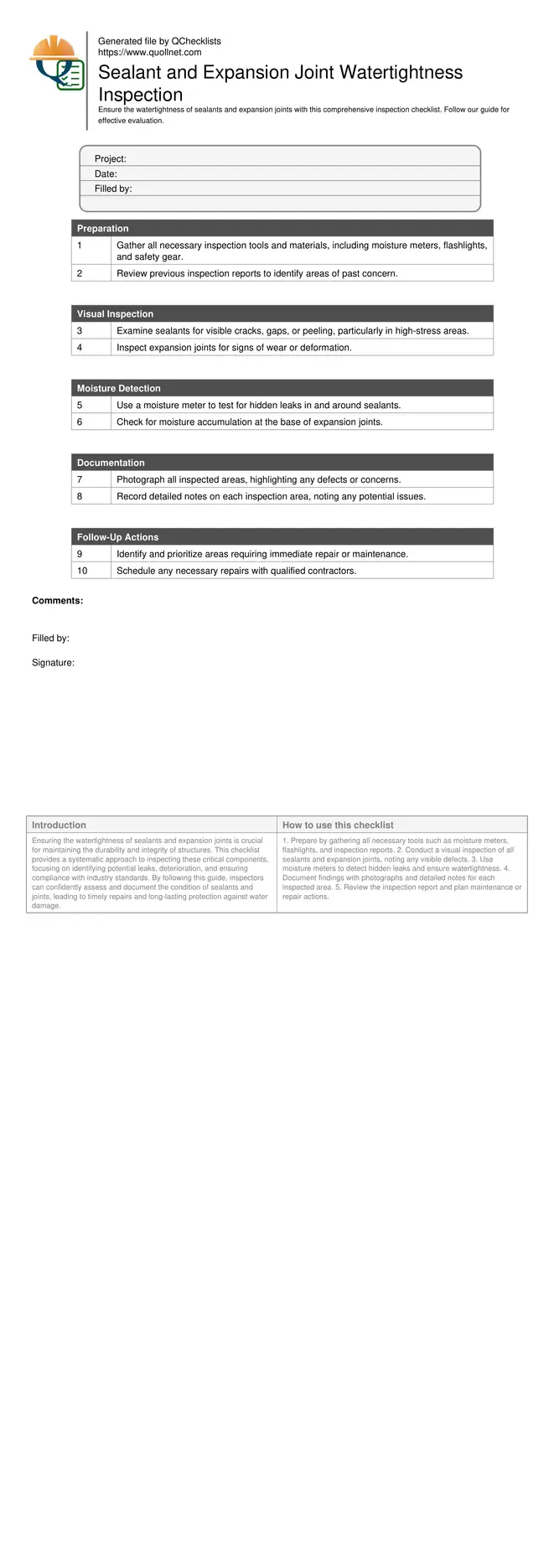Sealant and Expansion Joint Watertightness Inspection Checklist
Ensuring the watertightness of sealants and expansion joints is crucial for maintaining the durability and integrity of structures. This checklist provides a systematic approach to inspecting these critical components, focusing on identifying potential leaks, deterioration, and ensuring compliance with industry standards. By following this guide, inspectors can confidently assess and document the condition of sealants and joints, leading to timely repairs and long-lasting protection against water damage.
- Ensure structural integrity by identifying leaks and deterioration in sealants and joints.
- Facilitate proactive maintenance with systematic inspection methods.
- Improve compliance with industry standards for watertightness.
- Enhance documentation for repair and maintenance planning.
Preparation
Visual Inspection
Moisture Detection
Documentation
Follow-Up Actions
Understanding Sealant and Joint Functionality
Sealants and expansion joints play a vital role in accommodating structural movements and preventing water ingress. Understanding their functionality is essential for effective inspection. These components must be flexible to handle temperature fluctuations and building movements without compromising their water barrier role.
- Sealants accommodate thermal expansion and contraction.
- Joints allow for structural movement without cracking.
- Both prevent water ingress, protecting structural integrity.
Common Issues and Inspection Techniques
Inspecting sealants and joints involves identifying common issues such as cracking, loss of adhesion, and joint material degradation. Utilizing appropriate techniques like visual inspections and moisture testing ensures precise detection of defects. Regular inspections help in maintaining the structural health and extending the lifespan of the building.
- Look for visible cracks or tears in the sealant.
- Check for signs of moisture penetration around joints.
- Use moisture meters for accurate detection of leaks.
How to Use This Checklist Effectively
- Prepare by gathering all necessary tools such as moisture meters, flashlights, and inspection reports.
- Conduct a visual inspection of all sealants and expansion joints, noting any visible defects.
- Use moisture meters to detect hidden leaks and ensure watertightness.
- Document findings with photographs and detailed notes for each inspected area.
- Review the inspection report and plan maintenance or repair actions.
Call to Action
-
Start Interactive Checklist
Tick off tasks, leave comments on items or the whole form, and export your completed report to PDF or Excel—with a built-in QR code for authenticity.
- Download Excel - Sealant and Expansion Joint Watertightness Inspection Checklist
- Download PDF - Sealant and Expansion Joint Watertightness Inspection Checklist
- View Image - Sealant and Expansion Joint Watertightness Inspection Checklist

